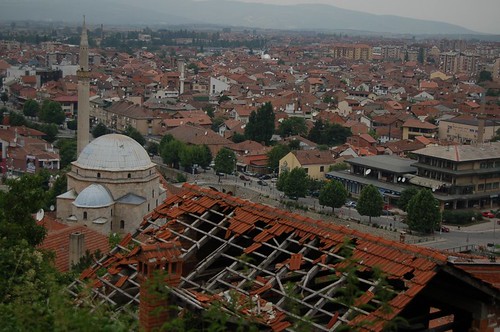Building on rotten foundations
Six years after the war, the picturesque city of
At the outset of the NATO bombing campaign, the OSCE has reported, Serbian military and police shelled a few areas of the city and destroyed the historic seat of the "League of Prizren," an important historical monument for Kosovo's ethnic Albanians. Yet, with the exception of the Tusus neighborhood, the "ethnic cleansing" of Prizren was carried out with a lesser degree of violence and fewer wanton attacks than in many other parts of Kosovo. […] In April 1999, on at least two occasions, Serb police and military rounded up hundreds of men in Prizren and forced them to serve on trench-digging brigades near the border with
(Read the full Human Rights Watch Report here)
Of course, no one can deny that some factions of the KLA (Kosova Liberation Army) also committed atrocities on the Serbs after the NATO air raids. But the tendency of the international community to level the systematic, widespread and state supported abuses of the one powerful side with the fewer cases coming from factions of the enraged, for years oppressed other side, without going further in their analysis, cannot be a good fundament for reconciliation. And cannot be so because this approach lacks the fundamental principles of justice.
There is no justice in giving “conditional independence” (isn’t that a contradiction in itself?) to Kosova arguing that they are not ready to deal with minorities rights based on their tense relations with the Serbian minority that, on the other hand, is not doing anything either to integrate into the local institutions and keeps tightly linked to the Serbian government in Belgrade.
And with that I’m not denying that there are minority issues to take care off in Kosova. There are, and some very urgent, but curiously the international community is not really taking effective care of these ones, thus making its whole discourse about minority rights sound like a big excuse to preserve the interests of Belgrade in the region.
I already learned that when most of the international actors here talk about “minorities’ problem”, they are really talking about “Serb minority”. But there are also some important Turkish and Bosniac minorities in Kosova and also a good number of Roma, Ashkali and Egyptian population, being these last three groups the ones in the worse situation right now. It is true, their numbers are smaller than those of the Serbs, and they are definitely not as powerful as the Serbian minority -with the support of Belgrade- is; but, precisely because of that, shouldn’t the international community have especial care of them and make sure that these historically prosecuted and discriminated groups had their rights ensured?.
The truth is that, while NATO troops and barbed wire surround orthodox churches and Serbian enclaves in Kosovo to protect them from possible attacks and Serbian minority’s rights are a keystone in the negotiations about Kosova’s final status, Roma and Ashkali population are still fighting for their basic rights. Their situation after the war was extremely difficult, as they were seen by the Albanian population as collaborators of the Serbs, and were prosecuted and denied basic Humanitarian help. Six years later, most of them still live in the called Internally Displaced People’s (IDP) camps, places without the most basic sanitary conditions where several cases of deaths by lead poisoning have already happened. From a
The United Nations
(Read the full article here)
Where is the interest of the international community for protection of minorities Human Rights in this case?
The relation between the different cultural groups in these region is not easy, it’s true, especially regarding the issue of independence: Serbian government is playing the card of the rights of its minority in Kosova to pressure the international community and avoid independence of the region, while independence is a MUST for the Albanian population that suffered the oppression of the Serbian government for decades. But, on the other hand, minorities such as the Roma and Ashkali, which were trapped in the games of power of the other two during the conflict and are seen by Albanians as collaborators of the Serbs, are afraid that an independent Albanian-ruled country will oppress them. Seems like a closed circle…
I’ve been thinking a lot about these circles -or rather spirals- of oppression and power, in which it seems to be always a more, disfavored group being mistreated by whom is at the same time being oppressed by a most powerful group. The spiral in Kosova, like everywhere else, needs to be broken, and I admit I don’t have the absolute answer on how to do it in the most just possible way. But it is clear to me that favoring the more powerful, the top layer of the spiral of oppression, forcing a reconciliation without justice into one of the oppressed groups, is just a way to feed the stream of violence and distrust all the way up and down. It is like building our house on rotten foundations. And we know that the international community is very fond to this option in the name of the sacred “stability”.
See more pictures of Prizren here
Sorry for the lonng post, I think I'm having too much time to think lately...


0 Comments:
Post a Comment
<< Home